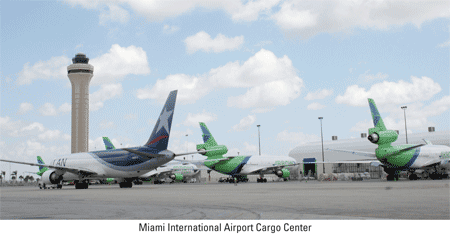 By Karen E. Thuermer, AJOT
By Karen E. Thuermer, AJOTLatin America is becoming increasingly strategic, not only from a political/trade perspective, but also for companies and their subsequent carriers that are serving this large and diverse market.
The United States continues to court South American nations to create the Free Trade Association of the Americas, a proposed agreement to eliminate or reduce trade barriers among all nations in the American continents, with the exception of Cuba and Venezuela.
Given that the FTAA seems doomed for now, the United States continues to embark on trade agreements with individual countries. The latest is with Peru.
Like most free trade agreements, the Peru Trade Promotion Agreement (PTPA) will eliminate tariffs and other barriers to goods and services and expand trade between the two nations. When implemented, the agreement will render 80% of consumer and industrial products, and more than two-thirds of current US farm exports, to Peru duty-free, immediately.
According to Everett Eissenstat, assistant US Trade Representative for the Americas, Texas, Florida, California, Louisiana, and Illinois will gain the most from the PTPA given that they already have the largest volume of exports of any states to Peru.
The International Trade Commission calculates that industrial and agricultural exports to Peru should increase annually by as much as $1.1 billion once the agreement is fully implemented.
“To date, it is the best agricultural deal we have ever negotiated in terms of access for US farmers and ranchers to other markets,” he says.
The clear winners will be US beef, pork, and poultry with advantages also for wheat, cotton, fruits, tree nuts, vegetables and vegetable products.
These commodities are big business with US seaports well connected in Latin America, among them the ports of Miami, Jacksonville, New Orleans, Philadelphia, Norfolk, and Houston. Most cargo arrives Peru via feeder vessel from its principal port, Callao. The Port of Callao is connected to the industrial area of Lima, Peru’s capital city, and the rest of country by access roads and the Central Railroad that crosses the Andes.
For air transport, Taca Airlines operates a hub in Lima with connections to Bogota, Buenos Aires, Caracas, Guayaquil, La Paz, Quito, Santa Cruz, and Sao Paulo. North American cities serviced are Boston, Chicago, Dallas/ Ft. Worth, Houston, Los Angeles, Miami, New York, San Francisco, Toronto, and Washington DC.
High value opportunitiesTrade agreements aside, high tech manufacturers find Latin America attractive for other reasons. Its huge consumer market, especially Brazil, and low cost wages for assembly are two attractive features. This is a big opportunity for a company like Hewlett Packard (HP) that sources its components from Asia, performs final assembly in Latin America, then ships finished products to consumers in the United States or Europe. A good portion of its products also remain in South America, where HP is the market leader for sales of personal computers. Tariffs are cheaper in South America and tax laws are favorable for local manufacturing, issues that go straight to the company’s bottom line. This is especially critical in the highly competitive world of electronics manufacturing. Cost is as important as speed to market is critical. This results in a perfect opportunity for air cargo carriers.
Air carriers respond.
Air cargo carriers understand all too well the profits that can be made on this run. American Airlines, which hauls more cargo as belly hold than any other passenger carrier in the world, benefits considerably from its connections to Latin America. Currently, the carrier provides non-stop service to Brazil, Argentina, Chile and Mexico—countries that have escalating trade with the Far East.
AA will introduce service to Buenos Aires via Miami and New York this Fall, utilizing Boeing 777


